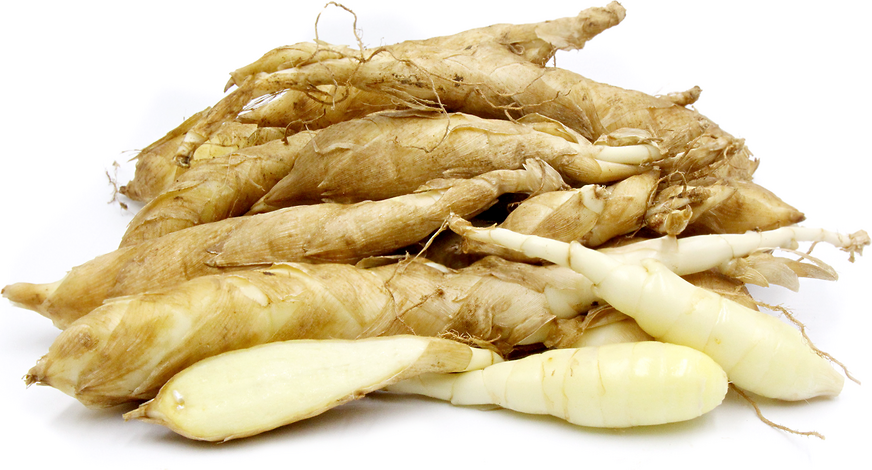


Arrowroot
Estimated Inventory, lb : 0
Description/Taste
Arrowroot varies in size, averaging 8-25 centimeters in length and 10-13 centimeters in diameter, and is generally conical in shape with slight tapering towards the non-stem end, similar to a carrot. The roots have a thin and papery brown skin that is layered in sections and can be peeled or washed off. Underneath the skin, the flesh is ivory to white and is firm, smooth, dense, and slightly aqueous, similar to the consistency of a raw potato. When consumed, Arrowroot is juicy with a mild, sweet flavor.
Seasons/Availability
Arrowroot is available in the late fall through early spring.
Current Facts
Arrowroot, botanically classified as Maranta arundinacea, is a leafy tropical plant with a starchy, edible, underground rhizome and is a member of the Marantaceae family. Also known as West Indian Arrowroot and Maranta, Arrowroot was one of the first plants to be cultivated in South America and has been utilized for thousands of years in ornamental, culinary, and medicinal uses. The name Arrowroot is likely a corruption of the word ‘aru-root’ from the Arawak people of South America. The belief is that the common name is derived from the root’s use as an antidote for poisonous arrows. Arrowroot is harvested approximately eleven months after sowing when the leaves have withered and died, and the roots are predominately ground into a powder and used as a starchy thickening agent in culinary applications.
Nutritional Value
Arrowroot is most nutritious raw and contains vitamins A and B6, thiamine, riboflavin, calcium, manganese, potassium, and folates. Once it is processed into powder, it loses much of its nutritional content but does contain fiber. Arrowroot can help protect the overall health of the body, promote circulation, and boost the immune system.
Applications
Arrowroot is commonly cooked prior to consumption when using the rhizome fresh, and it can be peeled, sliced, and prepared similarly to water-chestnuts. The white flesh can also be prepared like potatoes, roasted, grated, or chopped and added to soups or stews, or it can be cut into pieces and fried like chips. When included in soups, the root will have a slight thickening effect, but not nearly the same as the powdered Arrowroot starch. Making flour from Arrowroot is a relatively laborious process that includes stripping the thin skin from the roots, smashing them, letting the pulp sit in water, straining the pulp, and allowing the released starch to settle to the bottom. The water is changed out several times, and the collected starch is laid out in the sun to dry. The process can take up to two days, depending on evaporation time. The resulting white powder has a look and texture similar to cornstarch. Arrowroot powder remains clear and flavorless and is used in custards, glazes, sauces, jellies, pies, gravies, and baked goods. It is important to note that the powder should be made into a slurry, or a cool liquid mixture, before adding to hot temperature-wise mixtures to ensure that the powder does not clump. Arrowroot will keep in a cool, dark environment for up to two months. When sliced, Arrowroot will keep in the refrigerator for up to two weeks.
Ethnic/Cultural Info
The White House Cookbook published in 1887 had several recipes featuring Arrowroot powder. One recipe was for a dessert similar to panna cotta, called blanc-mange. Other recipes included Arrowroot milk porridge and an Arrowroot wine jelly that was given to ease cold and flu symptoms. Arrowroot can also be candied, just as eryngo and other roots were candied in late 17th century England. The “sweetmeat” confection was created by boiling the peeled rhizome in a simple syrup flavored with rosewater or lemon, then dried and dusted with powdered sugar.
Geography/History
Arrowroot is native to tropical regions of Central America, South America, and the West Indies and has been cultivated since 8200 BCE. When explorers arrived in the West Indies, they encountered the rhizome and brought it back to Europe, arriving in England in the early 18th century. The rhizome was also introduced to India, the rest of Asia, and Southeast Asia. Arrowroot tubers are still widely cultivated in the Caribbean and Central America today and can be found growing in tropical and subtropical regions throughout the world like South Africa, Australia, Asia, South America, and Southeast Asia. In the United States, Arrowroot can be found at some farmer’s markets and in home gardens in Florida.
Recipe Ideas
Recipes that include Arrowroot. One
| Eating Asia |
|
Long-Stewed Claypot Pork Belly |
| The Journal of a Girl who Loves To Cook |
|
Golden Chips |




